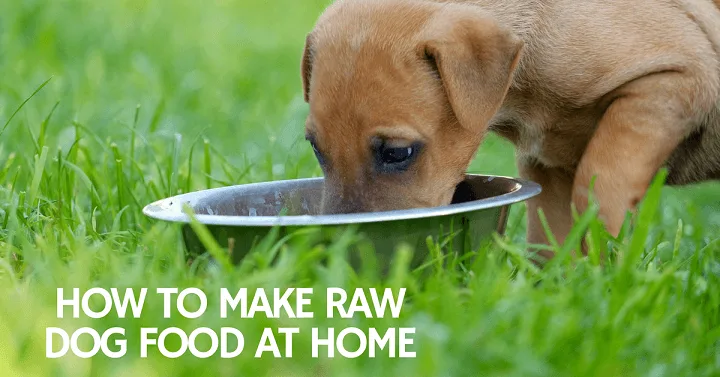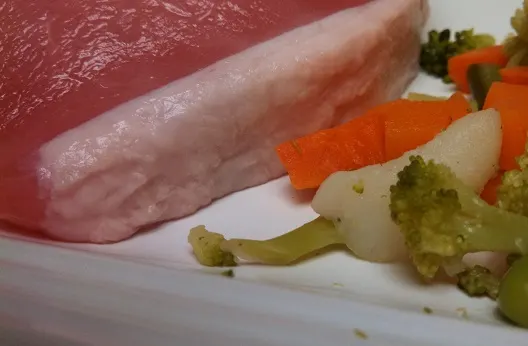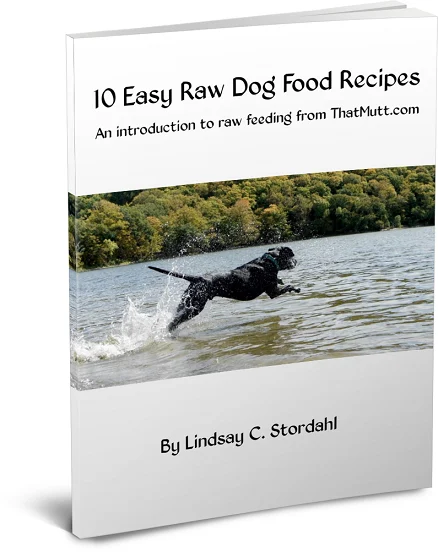How to make raw dog food yourself
Feeding a dog homemade raw food does not have to be complicated, but people are good about making anything complicated! We tend to worry way too much.
This article is intended to show newbies that raw feeding can be simple. You can make it more complicated down the road if you want, but getting started is easy.
You want to make sure your dog is getting enough variety in his raw dog food diet. As long as your dog doesn’t have specific health concerns, he should do OK as long as you feed the correct balance.
The following are some tips to help you get started feeding a dog raw food.

How I feed raw dog food
I make raw feeding as easy as possible.
I buy nearly all the ingredients at grocery stores, Costco, farmers markets and pet food stores.
I don’t have a huge freezer stuffed with food. I simply buy a week’s worth of food or so at a time, just as I would buy for myself.
Here is the basic ratio I try to follow for Ace’s raw dog food diet:
- 70 percent meat
- 10 percent organ meat (half of this is liver)
- 10 percent bone
- 10 percent fruits and veggies
Does this mean my dog gets two balanced meals every single day? Heck, no! He probably never gets a balanced meal.
This is just the basic ratio I strive for over any given week or month. In addition to the above, I also feed my dog:
- A tablespoon of cottage cheese or plain yogurt with most meals. He loves it!
- A fish-oil tablet once a day or so
- Sometimes a glucosamine tablet
How did I decide on that ratio?
I believe dogs are carnivores, but in order for dogs to benefit from a truly carnivorous diet, they would need the option of literally eating whole prey animals. You know, including the:
- blood
- eyes
- lungs
- brains
- tongue
- bones
- a little fur and feathers
While some raw feeders are able to provide this option for their dogs through a variety of excellent sources, I am not willing to do so at this time.
I would love to feed my dog portions of a whole deer or a whole rabbit, but frankly I don’t have the energy or the time or the storage right now.
The “whole prey model” of raw feeding typically focuses on feeding 80 percent meat, 10 percent bone and 10 percent organs.
I believe that is an excellent model, but I also like the idea of adding a small amount of fruits and veggies to my dog’s diet because it gives him a larger variety of nutrients.
Not all dog owners are going to agree on whether dogs need fruits and veggies, and that’s OK. We all have to make our own choices.
What types of raw food should I feed my dog?
Here are some examples of foods I regularly include in my dog’s raw dog food diet. I buy all of this at local grocery stores, ethnic grocery stores, Costco or pet food stores.
You can find better deals if you work directly with a butcher, rancher, farmer or possibly a CSA group.
Meat, organ meat and bones
Meat: “Whole” chickens (as whole as they come), chicken quarters, chicken thighs, chicken hearts and gizzards, turkey hearts and gizzards, ground meats, boneless pork chops, turkey thighs, boneless pork roasts, boneless beef roasts.
Organ meat: Beef liver, chicken liver, turkey liver, tripe (stomach lining), any kind of “innards” such as beef or pork kidneys. Check ethnic markets, butcher shops or the freezer section of natural pet food stores.
Bones: Ace only eats raw chicken and turkey bones within the meat such as when I give him a chicken quarter or a turkey thigh.
I do not feed any beef or pork bones, not even for “recreational chewing” because I don’t want him to swallow large chunks or hurt his teeth.
He also gets egg shells.
Fruits and veggies
Fruits: Apples, strawberries, raspberries, blackberries, blueberries, bananas. That’s about it. I don’t feed a ton of fruit.
Veggies: Pretty much anything I’m eating – Sweet potatoes, yams, zucchini, broccoli, red peppers, kale, spinach, dark lettuce, green beans, peas, carrots, squash, pumpkin.
Sometimes I chop the veggies up, but it’s better to blend or cook them for easier digestion. Remember, dogs aren’t exactly designed for eating veggies.
Other: Chicken eggs, canned sardines, fish oil, small amounts of plain yogurt, small amounts of full-fat cottage cheese
Is this perfect?
No. I’m simply doing the best I can. None of us eat perfectly healthy meals all the time, so that’s why my goal is always variety.
A variety of different types of meats in Ace’s raw dog food should always be my goal.
To make things easier, you could buy pre-made commercial raw dog food and use it for convenience feeding once or twice per week. Sure, it’s expensive, but it’s an easy way to add variety.
I recommend you buy a protein source that’s different from what you’d normally feed. For example, when I buy commercial raw dog food, I prefer to buy lamb or rabbit.
Well, that’s about as simple as I can make it! You may also be interested in my tips on how to make affordable raw dog food.
If you found this post helpful, you’ll definitely benefit from my ebook “10 Easy Raw Dog Food Recipes.” It goes over everything I’ve learned about raw feeding.
What are some raw ingredients you typically feed your dog?
Let me know in the comments!




Gail Rife
Saturday 23rd of February 2019
I have just started using your raw recipies for my dog. I also have parboiled my brocolli and carrots then smash them down with a motar and pestil. Should I par bolil my veges or not? My meat is given raw on the bone as you do
Lindsay Stordahl
Saturday 23rd of February 2019
Yes that should be fine
SUSANA F
Sunday 1st of April 2018
All me dog’s years (13) my vet insisted on no feeding bones because they splint (mentioning how many he had to surgically remove) so I’m concern about that. Is it too late to start at their advanced age?
chris
Wednesday 28th of March 2018
I have 7 freezers that I fill during deer hunting season with free deer meat (scraps, organs and bones) that I mostly feed to my german shepherds. That means I can feed my dogs for free pretty much. I supplement with organ meat (heart, liver, etc) from local sources and organic eggs or local eggs. I use a few supplements because of mostly feeding venison but also when there is a good deal on beef, pork or chicken, they get that too. I have healthy dogs with no vet bills. The most I have had to spend in health bills for my 8 year old and 9 year old is for chiropractic care for their backs. Otherwise I can testify to raw food being the best for my dogs health. We now have two 2 year old gsds who have been fed raw since we got them at 9 weeks old and the same thing. No vet bills, no health issues. yeah
Lindsay Stordahl
Wednesday 28th of March 2018
That's great! Thanks for sharing your experience.
Barbara Rivers
Tuesday 30th of August 2016
I get most of our raw meaty bones from our local supermarket - chicken leg quarters, chicken wings, & turkey necks. For the sake of variety, I also add duck necks which I purchase from Darwin's (also get beef & bison tripe from them). When I first started feeding raw, I would add a veggie/fruit pre-mix that I purchased from different brands online (Dr. Harvey's or THK), but nowadays I tend to make my own mix. I don't always add veggies & fruit - so I'm neither solely pro BARF nor Prey Model, lol. I'll add some of my homemade mix one or two weeks per month, and then just feed muscle meat, bones, and organs the rest of the time.
Sharon
Sunday 27th of March 2016
I heard that you are not supposed to give dogs chicken bones, because they could choke, but you say your dog eats whole chicken legs. Is this boneless chicken?
Lindsay Stordahl
Sunday 27th of March 2016
Raw chicken with raw bone is generally safe for dogs. The raw bones are very soft for them and pliable. When they are cooked, that is when they are more dangerous because they can become very sharp or splinter. Of course, any type of chew you give your dog has a slight risk of choking hazard, that goes for rawhides, etc.